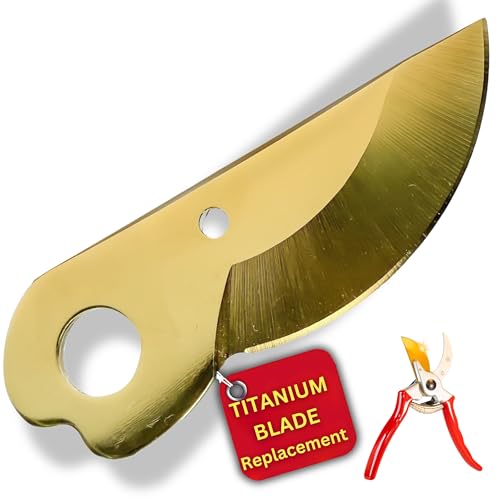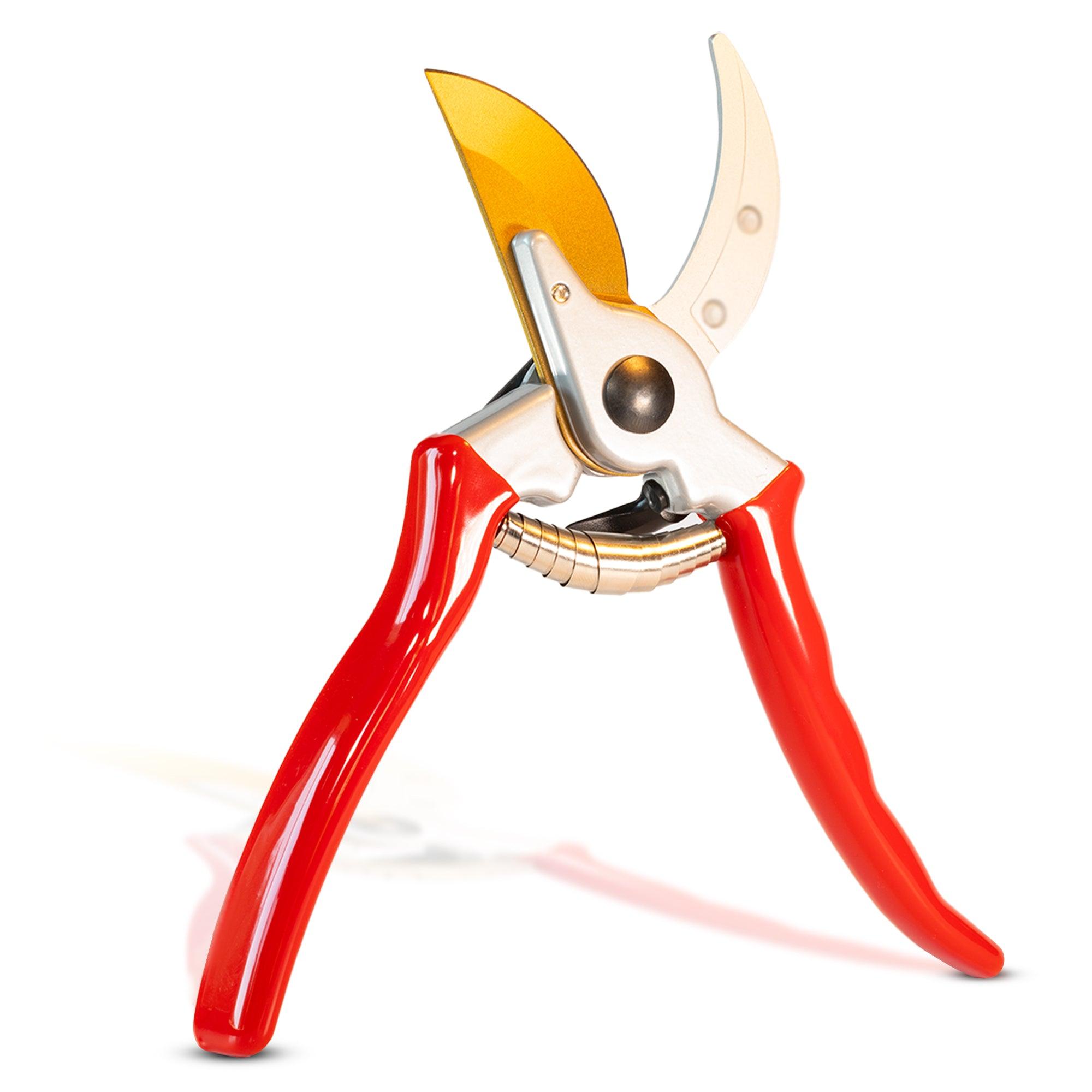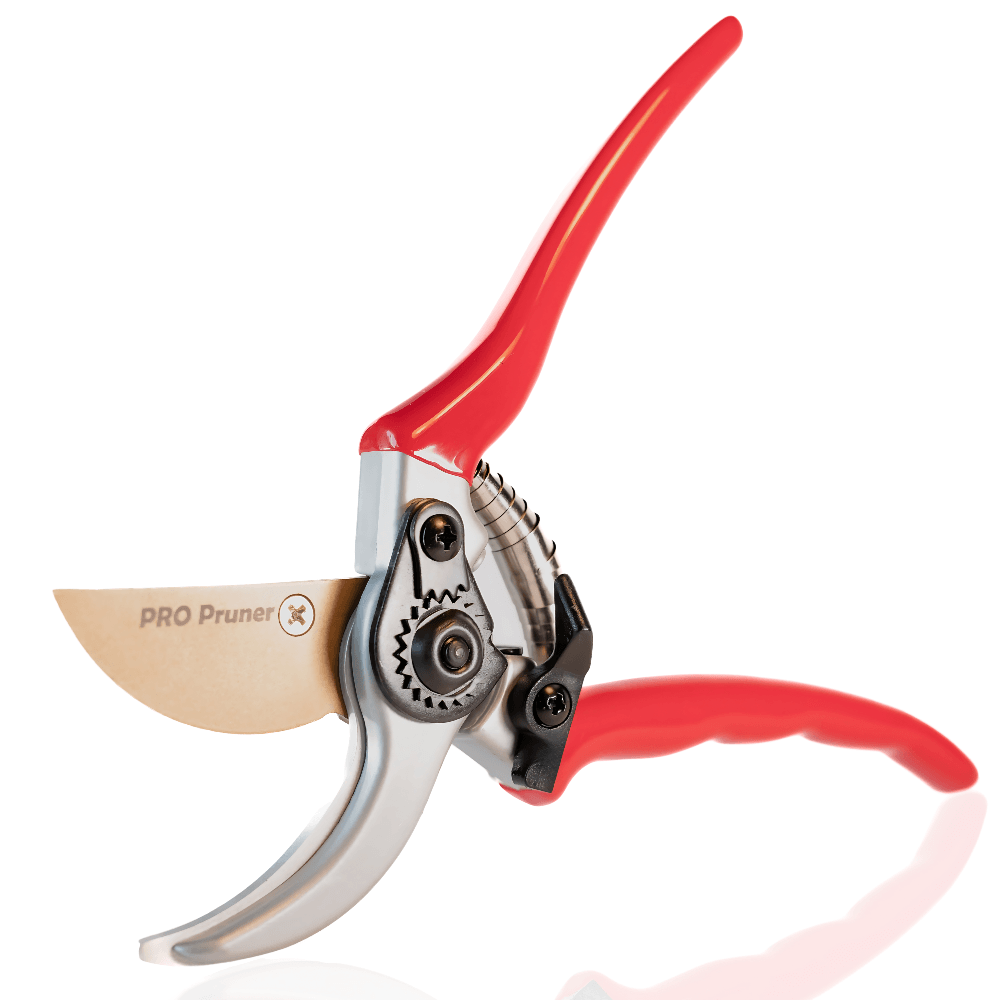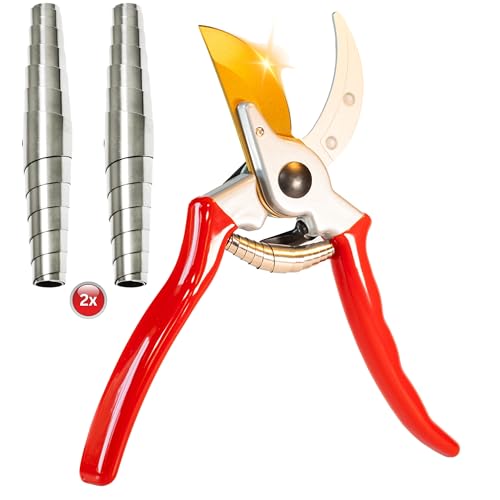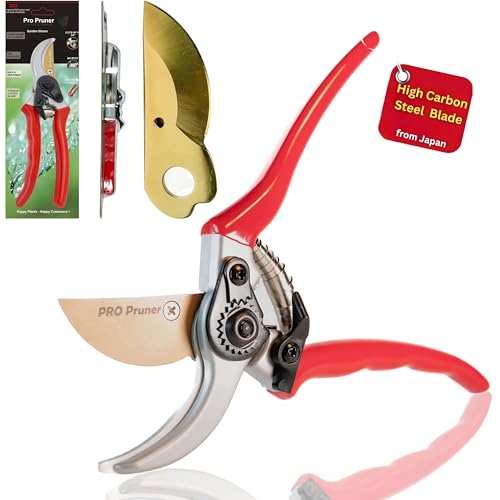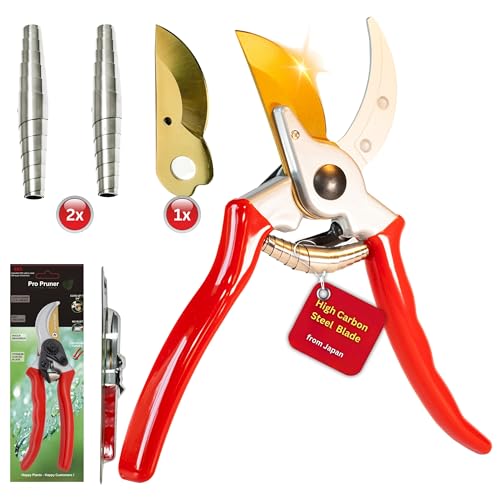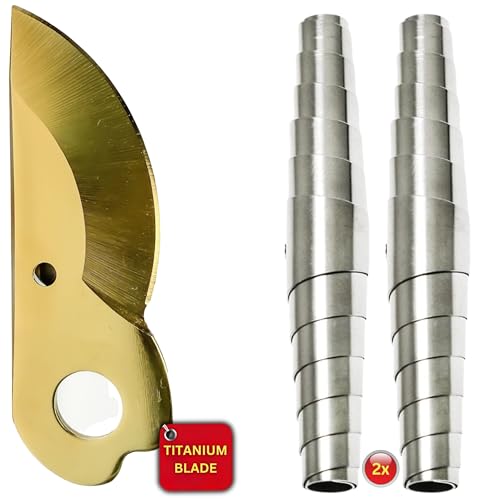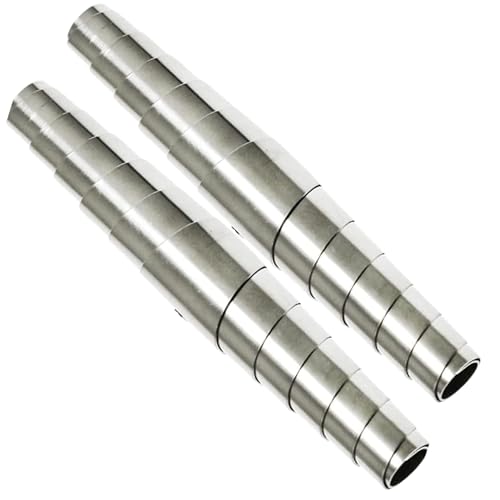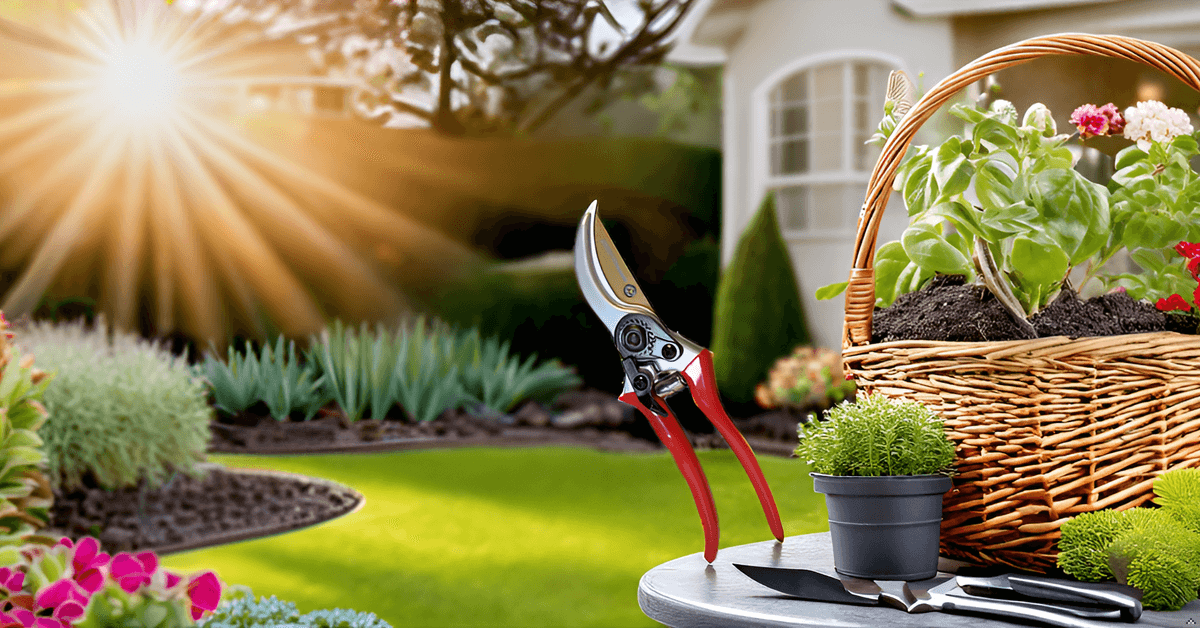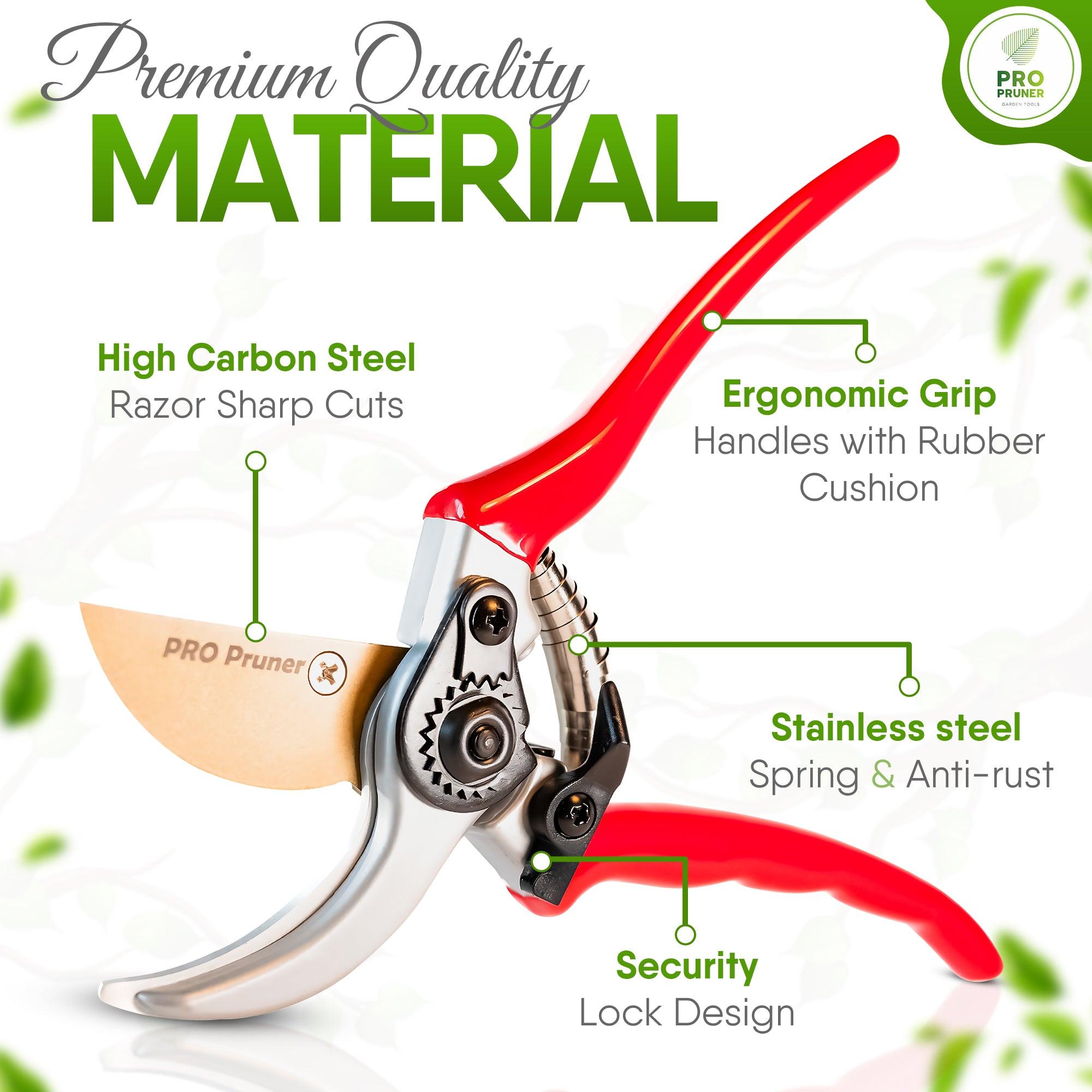
-
Clean the Blades After Every Use
To keep your Pro Pruners sharp and effective, wipe the blades down after every use. Removing plant sap, dirt, and residue helps maintain cutting precision. -
Keep the Blades Sharp
Sharp blades make cleaner cuts, which helps plants heal faster. Regularly hone or sharpen your shears to keep them performing at their best. -
Lubricate the Blades and Pivot
A small drop of oil on the pivot point keeps your shears operating smoothly. It also prevents rust and makes each cut easier. -
Use the Right Pruning Technique
For most branches, make a clean, single cut rather than sawing or twisting. This prevents ragged edges and reduces the risk of damaging the plant. -
Sterilize the Shears Between Plants
To prevent disease spread, sterilize your shears with rubbing alcohol or a bleach solution between plants, especially when cutting diseased branches. -
Use a 45-Degree Angle for Healthier Cuts
Always cut branches at a 45-degree angle to help water roll off, which reduces the risk of rot and disease. -
Prune at the Right Time of Year
Know the best season for each plant. Prune flowering shrubs after they bloom, while most perennials do best with early spring pruning. -
Choose the Right Grip
Use a relaxed grip on your Pro Pruners to prevent hand fatigue. Let the ergonomic design support you for comfortable, longer pruning sessions. -
Protect Your Hands with Gloves
For extra protection, wear gloves while pruning to avoid scratches or blisters. Gloves also offer a better grip, especially in wet conditions. -
Use Shears for Routine Deadheading
Remove faded blooms from flowering plants to encourage new growth. Deadheading directs energy to new blooms, extending the flowering season. -
Prune Dense Growth to Prevent Mold and Pests
Air circulation reduces pest and mold issues. Use your shears to thin dense growth, keeping your plants healthier. -
Avoid Cutting Large Branches with Shears
Pro Pruners are perfect for small to medium branches, but for large branches, use a pruning saw. This prevents damage to both the plant and your shears. -
Check for Worn Parts Regularly
Inspect your shears for signs of wear. Springs, screws, and blades may need replacing over time to ensure optimal performance. -
Store Shears in a Dry Location
After cleaning, store your Pro Pruners in a dry place to prevent rust. A tool pouch or hook works well, keeping them in great shape. -
Prune for Shape and Growth
Shaping plants encourages healthy growth and a fuller appearance. Use regular pruning to train plants, keeping them attractive and healthy. -
Keep a Steady, Gentle Pressure on the Handles
Avoid squeezing too hard, which can lead to hand strain. Instead, let the design of your Pro Pruners do the work for smooth, effortless cuts. -
Practice Proper Pruning for Flowering Plants
For flowering plants, cut just above a bud or node to encourage new blooms. Proper cutting helps plants allocate energy effectively. -
Deadhead Perennials in Early Summer
For plants that bloom in late summer, deadheading in early summer directs energy to late-season flowers, creating a more abundant display. -
Avoid Pruning During Wet Weather
Pruning in wet conditions increases the risk of spreading disease. Dry weather is best for plant health. -
Use Both Hands When Needed
For thicker branches, use both hands to apply even pressure. This helps avoid overexerting one hand and keeps cuts more precise. -
Focus on Removing Dead or Damaged Wood
Begin by cutting away any dead or damaged branches. This ensures that healthy parts of the plant get the most sunlight and nutrients. -
Maintain the Spring Mechanism
The spring mechanism between the handles reduces hand strain. Check its elasticity regularly and replace if it starts to weaken. -
Don’t Overuse Your Shears on Hard Materials
Avoid using Pro Pruners on hard objects like wire or metal ties. This can dull or damage the blades, reducing their effectiveness. -
Prune for Improved Sunlight
Trim branches to allow sunlight to penetrate the plant, especially for shrubs and trees. This promotes photosynthesis and encourages healthier growth. -
Plan Your Pruning Strategy in Advance
Before making cuts, visualize the result you want for the plant. Planning helps you make strategic cuts that support the plant’s health and growth.
These tips will help you use your Pro Pruners with skill and precision, keeping your garden looking its best while promoting plant health. Following these guidelines ensures that every cut contributes to a thriving, beautiful landscape.
When to Prune Your Plants: A Seasonal Guide for Healthier Growth
Pruning plants at the right time of year is crucial to their health, shape, and flowering potential. This guide will help you determine the best pruning times for specific plants, so you can ensure they thrive all year long. Here’s when and how to prune popular plants like Acer maples, conifers, ornamental grasses, ivy, and more.
- Acer Maples – Late Summer to Early Fall Acer maples, known for their beautiful foliage, benefit from pruning in late summer to early fall. Pruning during this time minimizes the risk of bleeding sap, which can occur if pruned in early spring. Remove dead, damaged, or overcrowded branches to improve air circulation, shape, and overall health. Avoid heavy pruning, as this can reduce next year’s foliage display. Light pruning also ensures these delicate trees keep their natural shape and maintain their vibrant fall colors.
- Conifers – Late Winter or Early Spring Conifers, such as pines, firs, and spruces, thrive when pruned in late winter or early spring, just before the growing season begins. Pruning during this dormant period minimizes stress and encourages healthy growth. Focus on removing dead or damaged branches, as conifers don’t respond well to hard pruning. For conifers that grow in specific shapes, like topiaries, prune a few times throughout the season to maintain the form, but always avoid cutting into old wood, as they don’t regenerate well from older sections.
- Ornamental Grasses – Late Winter to Early Spring Ornamental grasses should be left untouched in fall and winter, as their stalks add beauty and movement to the garden during colder months. In late winter or early spring, before new growth begins, cut back the dead grass to about two to three inches above the ground. This approach allows new shoots to emerge unimpeded and keeps the plant looking fresh. Some ornamental grasses, like fountain grass, can even be split and replanted in spring to increase your garden coverage.
- Ivy and Vines – Late Winter or Mid-Summer Ivy and other vining plants benefit from a structured pruning schedule. Prune in late winter to control growth, shape the plant, and remove damaged or weak sections. For rapid growers, consider a mid-summer pruning to keep them in check and prevent them from overtaking nearby plants. Cutting back excess growth helps promote healthier foliage and encourages flowering in some vine varieties.
- Perennials – Late Fall or Early Spring Perennials, which return year after year, generally need pruning either in late fall after the first frost or early spring before new growth appears. For varieties that provide winter interest, like sedum and coneflower, consider leaving the seed heads intact until early spring. This helps provide habitat for beneficial insects and winter food for birds. For other perennials, cutting them back in late fall can keep your garden tidy and reduce the chance of disease over winter.
- Groundcovers – Early Spring Groundcovers like creeping thyme, vinca, and ajuga don’t require intensive pruning but do benefit from a light trim in early spring. Pruning in spring encourages fresh, dense growth and helps keep them within their designated areas. For groundcovers that spread aggressively, you may need to prune them more frequently throughout the season to prevent them from taking over neighboring plants.
- Topiary – Every 4 to 6 Weeks During Growing Season Topiary plants, with their beautiful and controlled shapes, require consistent pruning to maintain their form. During the growing season, typically every four to six weeks, trim back new growth. This frequency encourages compact, dense growth and keeps the shape clean and precise. In winter, avoid heavy pruning as the plant’s growth slows; however, a light trim can help maintain the desired shape.
General Tips for Pruning by Season:
- Spring: This is the time to prune flowering plants that bloom on new growth, as well as rejuvenate shrubs and trees.
- Summer: Light pruning in mid-summer can control rapid growers and thin plants for better air circulation.
- Fall: Remove dead and diseased growth, particularly on plants prone to winter damage.
- Winter: This is the time for most conifers and hardwoods. Winter pruning minimizes sap loss and allows easy identification of damaged branches.
Pruning plants at the optimal time not only enhances their appearance but also promotes healthier, more vigorous growth. By timing your pruning correctly, you’ll enjoy a thriving, beautiful garden year-round.
Why Pruning is Essential for Plant Health and Beauty
Pruning is an important practice for gardeners, homeowners, and anyone who wants their plants to thrive. But why is pruning necessary, and what benefits does it offer? Let’s dive into the key reasons pruning is essential for healthy, beautiful plants and how it helps them reach their full potential.
- Encourages Healthy Growth
Pruning removes dead, damaged, or diseased branches, preventing decay from spreading to healthier parts of the plant. When a plant is free from these problem areas, it can focus its energy on producing new, healthy growth. Regular pruning also promotes air circulation through the branches, reducing the risk of fungal infections and other diseases. By keeping the plant open and well-ventilated, pruning encourages robust growth and improves the overall health of the plant.
- Shapes the Plant for Aesthetic Appeal
One of the most visible benefits of pruning is the aesthetic enhancement it provides. Pruning helps shape plants, keeping them tidy, balanced, and attractive. For flowering shrubs, trees, and ornamental plants, pruning can help maintain a desired form, whether it’s a natural, bushy shape or a refined topiary. Shaping plants through pruning not only makes them look well-maintained but also allows you to highlight their natural beauty and improve the garden’s overall design.
- Stimulates Flower and Fruit Production
Pruning can directly influence the productivity of fruit-bearing plants and flowering shrubs. For example, many flowering plants, such as roses, produce more blooms after being pruned. By removing old or non-productive branches, the plant directs its resources towards new growth and flowering buds. For fruit trees, pruning opens up the canopy, allowing sunlight to penetrate and reach the fruiting branches. This practice results in larger, healthier fruits, and makes harvesting easier.
- Increases Light and Airflow
Crowded branches and dense foliage can block sunlight and restrict airflow, creating an environment where pests and diseases thrive. Pruning opens up the plant’s structure, allowing light to penetrate more deeply and air to circulate freely. For indoor plants or plants growing in shady areas, this increase in light can be especially beneficial. By improving airflow, pruning also reduces moisture buildup, helping to prevent fungal infections and rot.
- Prevents Overgrowth and Maintains Size
Left unchecked, many plants can quickly outgrow their intended spaces, encroach on nearby plants, or become unruly. Regular pruning helps keep growth in check, especially for fast-growing species. By controlling size, pruning ensures that the plant doesn’t compete excessively for resources with surrounding plants, making it an effective way to manage limited garden space. For hedges, trees, and shrubs, consistent pruning keeps them from overpowering the landscape and maintains a manageable size and shape.
- Removes Hazardous Branches
For large trees, overhanging branches can pose a safety risk to structures, people, and vehicles. Pruning removes weak or damaged branches that could fall during a storm, making it a key step in landscape safety. This is especially important for older trees, where dead or weakened limbs may be at risk of breaking. In public spaces, pruning can prevent accidents, and around the home, it keeps your outdoor areas safe for family and visitors.
- Enhances Plant Longevity
Pruning can prolong the life of many plants. By removing dead or diseased branches, you prevent infections from spreading, which can ultimately kill the plant if left unchecked. Pruning also keeps plants youthful, encouraging vigorous growth and increasing their resilience to pests and environmental stress. In essence, a well-pruned plant is a healthier, more resilient plant that can live longer and produce better results year after year.
- Promotes Root Health and Stability
For many plants, particularly trees and large shrubs, pruning reduces the burden on the root system by limiting the canopy size. This helps the plant allocate its resources more effectively, as the roots don’t have to support as much overhead weight. This balance between roots and branches promotes stability, reducing the risk of top-heavy plants that may topple in strong winds or unstable soil.
- Supports Seasonal Changes and Dormancy
Pruning is essential for plants that have seasonal growth cycles. For deciduous trees and shrubs, winter pruning encourages new growth in spring. Cutting back these plants while they’re dormant helps prepare them for an active growing season, allowing for an abundance of flowers and foliage when warm weather returns. On the other hand, pruning summer-flowering plants after their bloom period directs energy to root development during fall and winter, setting the stage for a productive spring.
- Boosts Curb Appeal and Property Value
A well-pruned garden adds beauty and curb appeal, increasing property value and making outdoor spaces more enjoyable. Homes with neatly maintained plants look more welcoming and are easier to care for over time. For those considering selling their property, a tidy, thoughtfully pruned landscape makes a positive first impression, potentially raising buyer interest and the home’s market value.
Conclusion: The Benefits of Regular Pruning
Pruning is not just about trimming branches; it’s about shaping plants, enhancing health, and encouraging their natural growth. By investing time in regular pruning, you’re ensuring your plants reach their full potential, resist disease, and create a more beautiful and productive landscape. From ornamental shrubs to fruit trees, every plant can benefit from strategic pruning, making it an indispensable tool for gardeners and plant lovers alike.
Why Pro Pruners Are the Ultimate Choice for Garden Enthusiasts
When it comes to garden tools, few are as essential as a good pair of pruning shears. But with so many options on the market, why should you choose Pro Pruners? From their durable build to their ergonomic design, Pro Pruners offer unmatched quality and performance that sets them apart. Let’s take a closer look at why Pro Pruners are the ultimate choice for gardeners, landscapers, and plant enthusiasts everywhere.
- Superior Blade Quality
At the heart of any pruner is its blade. Pro Pruners use high-quality carbon steel, ensuring the blade remains sharp over time, even with frequent use on tough branches and stems. The carbon steel is hardened and treated for durability, resisting rust and wear. This quality makes Pro Pruners especially effective for precise cuts, which are essential for plant health and recovery. Clean cuts heal faster, reducing the chance of infection and promoting robust growth.
- Ergonomic Design for Comfort
Pruning can be a strenuous task, especially for larger gardens or prolonged sessions. Pro Pruners are crafted with an ergonomic handle design that fits comfortably in your hand, reducing hand fatigue and preventing strain. The soft-grip handles provide added comfort and control, so whether you’re pruning delicate flowers or cutting back thicker branches, your hand and wrist remain protected. Pro Pruners allow you to work longer with minimal discomfort, making them ideal for both professional and casual gardeners.
- Built for Heavy-Duty Use
Pro Pruners are made to withstand the demands of frequent, heavy use. With reinforced construction and robust materials, these pruners are designed to handle rigorous tasks without bending or breaking. The tool’s structure absorbs impact effectively, so you can confidently tackle challenging pruning jobs on trees, shrubs, and dense hedges. Pro Pruners maintain their integrity and effectiveness over time, proving to be a long-term investment for anyone serious about gardening.
- Precision Cutting for Healthier Plants
One of the biggest advantages of using Pro Pruners is the precise cuts they produce. Pruning isn’t just about removing unwanted growth; it’s about ensuring each cut promotes health and vitality in the plant. Pro Pruners deliver smooth, clean cuts that allow plants to heal quickly, preventing disease and improving their growth potential. Unlike cheaper pruners that may tear or damage plant tissue, Pro Pruners provide the exact cut needed for optimal plant health.
- Advanced Safety Features
Pro Pruners come equipped with a reliable locking mechanism that keeps the blades safely closed when not in use. This feature is particularly useful for those with children or pets around and helps prevent accidents when the pruners are stored. The lock is easy to engage and disengage, ensuring that you can safely and confidently carry or store your pruners without worry. Safety is a key focus of Pro Pruners, making them a dependable choice for users of all experience levels.
- Versatile Use for All Types of Pruning
Whether you’re shaping hedges, pruning roses, or trimming back overgrown branches, Pro Pruners are designed to handle a wide range of tasks. Their versatility makes them an invaluable tool for both beginner and expert gardeners. You can use Pro Pruners on woody stems, thin branches, and even delicate blooms without compromising the quality of the cut. This flexibility eliminates the need for multiple pruning tools, as Pro Pruners can easily adapt to different tasks and plant types.
- Reduced Hand Fatigue and Strain
Gardeners know that prolonged pruning sessions can lead to hand strain and discomfort, particularly when using poorly designed tools. Pro Pruners are crafted with a focus on reducing strain, featuring cushioned handles and an ergonomic shape that fits naturally in your hand. The non-slip grip ensures control even in wet conditions, allowing you to prune confidently without the risk of losing your grip. This thoughtful design means you can complete longer pruning jobs with ease and comfort.
- Lightweight Yet Powerful
Despite their robust construction, Pro Pruners are remarkably lightweight, allowing for ease of use without compromising strength. The lightweight design makes it easy to maneuver, especially in tight spaces or when working on intricate pruning tasks. For those working on larger properties or extensive pruning jobs, the lightness of Pro Pruners helps prevent arm fatigue, allowing you to work efficiently for longer periods.
- Easy Maintenance and Long-Lasting Performance
Pro Pruners are designed with durability in mind, but they’re also easy to maintain. The blades can be easily cleaned and sharpened, ensuring they remain in top condition for years to come. The design also allows for simple disassembly, so you can clean and care for your pruners thoroughly. With proper maintenance, Pro Pruners will serve you reliably, season after season, making them a smart investment for any gardener.
- Designed with Sustainability in Mind
Pro Pruners are built to last, reducing the need for frequent replacements. Unlike cheaper tools that may need to be replaced regularly, these pruners are designed for extended use, contributing to less waste and a more sustainable gardening practice. Choosing high-quality, long-lasting tools like Pro Pruners helps reduce your carbon footprint while enhancing your gardening experience.
- Trusted by Professionals
Pro Pruners have earned the trust of professional landscapers and gardeners worldwide. Their superior performance, reliability, and durability make them a top choice for experts who need tools they can count on. When you choose Pro Pruners, you’re choosing the same level of quality that professionals rely on, ensuring you’re well-equipped for any gardening task.
- Backed by a Satisfaction Guarantee
Confidence in the quality of Pro Pruners extends to a satisfaction guarantee. Knowing that your pruners are backed by this commitment gives peace of mind that you’re investing in a high-quality tool. If for any reason you’re not satisfied, you have the assurance that customer support is ready to assist you.
Conclusion: Elevate Your Gardening with Pro Pruners
Pro Pruners stand out among garden tools for their exceptional craftsmanship, comfortable design, and unmatched cutting precision. From heavy-duty durability to ergonomic comfort, Pro Pruners provide everything a gardener needs to achieve professional-quality results. When you invest in Pro Pruners, you’re not just buying a tool; you’re investing in a reliable companion that will help your garden flourish. With Pro Pruners, you can enjoy the art of pruning with confidence, knowing you have a tool that enhances your skills and elevates your gardening experience.

